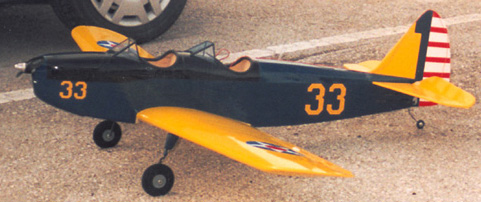|
Have good flights,
Paulo "Chispas" Faustino, Portugal
Return to "What's In This Issue?"
Gearbox Replies
From: James Frolikjdfrolik@freenet.de
Ken,
I've received absolutely no emails concerning gearbox selection for a 5-blade prop. (There have been several by now. Took some time to get this in here. KM) Thanks anyway for posting my query in the EFO Newsletter. I think I'm in uncharted territory here, and many modelers probably feel it's too many blades for what might be negligible, if any, gain -- or even a loss in performance. ("Looks great! But how does it fly?")
I received a nicely machinge AluGear 480 made in Korea and sold here without a name label. It's a planetary 3.8:1 with 4mm prop shaft and only cost about $28US. It seems to be just what I'm looking for and is much quieter than anticipated. I'm using a standard Speed 480 motor.
I'm sending everything to Christian Ramoser, the varioPROP manufacturer, for measurement testing. He's got a thrust stand and additional equipment I don't have.
Thanks for helping.
Return to "What's In This Issue?"
RC PlaneMaster
From: Anthony Tate Anthonytate1@aol.com
Just a brief note regarding the flight simulator mentioned in your web-site (newsletter). I have been using RC PlaneMaster for about two weeks now, and not only are the flight characteristics very true to life for MODEL aircraft, particularly so in the case of the demo aircraft; ME109, but the after-sales service is superior to any business that I have had dealings with for many years. I have even posted a question, via the Internet, on a late Sunday afternoon, expecting a reply some time during the coming week. I had a reply THAT SAME EVENING, SUNDAY. This guy runs the sort of business that could be a role model for the rest of the world! You have probably guessed that I am impressed, both with him, and his product. Try it, you will be equally impressed, I am sure.
Yours,
Anthony Tate
P.S. I don't know about a Mac version. (There isn't one. KM) Get in touch with Kevin at Realitycraft. I'm using Windows XP. Correction, I'm learning to use Windows XP. I've had the PC for about eight months. I'm more used to brushes. I'm an artist, specialising in Fantasy Portraits. These electronic whing-dings are beyond me! Thank goodness I don't need them to build model aircraft with. I would never get off the ground!
Return to "What's In This Issue?"
Twin Brushless With Single ESC
From: Dave Harding davejean1@comcast.net
Ken, just a quick note, thanks for your continued efforts with the Ampeer.
I noted in the latest one some discussion about using two brushless in an A-26. Someone noted that two controllers would be required. Of course, this is not the case. In fact, the installation would be better with a single controller as the motors would be perfectly matched. There has been much discussion on this application on the various Web pages. I personally watched Steve Neu fly his Me 110 in San Diego some years ago. After the usual hesitation on initial start they worked perfectly.
Perhaps you would like to comment on this in the next issue.
Dave Harding
You've already commented on it. I've read that it works, but I've not yet seen it personally. Try it. If it doesn't work, you can always get the second controller. KM
Return to "What's In This Issue?"
Profili: Airfoil Plotting Program
From Bruce van-Schalkwyk bvschalk@law.syr.edu
Ken,
The new link to Profili: www.profili2.com
(It looks like they are doing a limited-time freeware and then one needs to register).
Thanks for the great site!
Bruce
If you are looking for an airfoil-plotting program, this is a good one. I put the link in here, as all the links on the EFO site might not be current, as Bruce pointed out in his e-mail. Thanks Bruce. KM
Return to "What's In This Issue?"
varioProps & More
From: Scott Blacksblack@progression.net
Hi Ken,
I just had a look at the January Ampeer and had a couple of quick comments.
First, regarding the vario props, we have to remember here that there are a lot of variables. If a guy puts a 4 blade prop on his motor and runs it, then puts a 5 blade prop on, he has changed much more than the prop. He has also changed the operating point of the motor. We should all remember that a motor's efficiency is dependant on its load. Recall the curves that many of us used to generate with spreadsheets and such a few years ago when we were first trying to figure out how to best use our motors. If you are way off the peak then your efficiency changes and the addition of another prop blade is certainly enough to move it significantly. To really isolate the prop efficiency is quite difficult.
Also, consider that the operating point in the air will be way different than on ground.
Theoretically speaking, disregarding the optimal loading of the motor, the larger diameter prop will always be more efficient, hence really a single blade prop will be the best provided that the tip speeds are not transonic. However here are three reasons for going to a multi-blade prop and they are all completely valid:
1) prop clearance
2) scale accuracy
3) 'cause it's cool and you felt like it!
Also, regarding Li-Po fires, don't make an aluminum box to charge your cells in - aluminum burns quite nicely and even if it doesn't ignite it will melt on your pack to make a great blob. I would suggest a large Tupperware pot of sand. In the shop I charge mine on a firebrick (same one I use for brazing and other torch work) and I have the pot of sand handy. If you do have a fire that is the only way to stop it - pour the sand on and smother it. A CO2 extinguisher won't cut it, a dry chemical one will but it is pricey, so go with a pot of sand.
Finally, regarding CG, this is a topic that so many people struggle with. It is nice to see Keith's article which concentrates on trim (the balance beam analogy) and stability (the dive test). The equation for
Mean Aerodynamic Chord is
MAC = 2/3* root chord * (1+lamda^2 + lamda)/(lamda + 1) where lamda =
tipchord/rootchord i.e. taper ratio.
Why? Because this describes the centroid of a quarter ellipse, which is the assumed shape of the lift distribution. For straight taper wings without kinks, this results in the MAC occurring at about 41% of the semi-span i.e. 41% outboard from the wing root. I always measure from the airplane centerline, which is the usual convention.
I never bother with the equation anymore. I find the 41% line (ok, I confess, I use 40% because this is not an exact science) and stick the CG between 28% and 30%. None of my designs, including the Sabre, Pond Racer, twins, jets, you name it, has ever needed significant adjustment.
Just remember than the elevator deflection has to be appropriate. If you stick the CG at 20% MAC you will need lots of throw and probably lots of trim. If you put it at 35% (the pattern guys do) you will need small throws and/or a ton of expo. Mix those combinations up and you will have an interesting flight. Bring a rake and a bag!
Return to "What's In This Issue?"
Kontronik Electric Power Systems Info
From: HROSE@hobbico.com
I recently received this somewhat amusing, in parts, press release from Hobbico/Great Planes via E-mail. Try not to smirk or snicker too much as you read through "Advantages of electric powered flight:" part of it. Like we didn't know! It is nice to know that a major supplier of R/C products realizes where the future is. The future is electric. KM
The future of electric flight is here - and we've got it!
Catch the new wave of "brushless technology" in R/C aircraft power!
Even though electric airplanes have been around for years, glow-powered models have traditionally been preferred by R/C pilots - mainly due to their power and performance. But all that's about to change.
Great Planes is now the exclusive distributor in North America for Kontronik, a world leader who specializes in high-end electric flight products. Their advancements in brushless motors, ESCs and gear drives have resulted in electric power systems that match the performance of glow engines. For modelers who have always wanted the simplicity of electric flight - with the performance of glow power - now there's Kontronik! Make sure you're at the forefront of the electric flight revolution, by stocking Kontronik electric power systems!
Advantages of electric powered flight:
Cheaper - no need to repeatedly buy fuel, glow plugs, glow engine maintenance accessories, fuel pumps, power panels, safety sticks or starters, etc.
Simpler - it's "plug and play"; connect the battery to the ESC and GO; no engines to break in and carbs to tune.
Cleaner - no fuel to spill (or clean off of a model's finish), no odors or fire hazards
Quieter - an important consideration with non-modeling neighbors.
All Kontronik Brushless ESCs can be used with sensored or sensorless motors and include:
- "Soft-start" safety feature
- Anti-drift, temperature and current overload protection
- Current limiting feature
- Auto Programming mode for quick and easy setup of the ESC
- RPM control for governing a heli's main rotor speed
"Smile" Brushless ESCs
- Competitively priced, and designed for easy operation by intermediate-level fliers.
- Features different programmable default settings for airplanes, helis, gliders, cars and competition
- EMF brake has 2 brake strength settings
- High frequency 8kHz operation
- Adjustable low voltage cutoff protection for NiCd and NiMH batteries
| Model: | Smile 30-6-12 | Smile 40-6-12 |
| Input # cells: | 6-12 | 6-12 |
| BEC: | 5V/2A | 5V/2A |
Max. constant
current: | 30A | 40A |
Max. surge
current: | 40A | 50A |
| Weight: | 1.0 oz (29g) | 1.1 oz (31g) |
"Jazz" Brushless ESCs
- More features for the advanced pilot
- Includes programmable modes for planes, helis, gliders, cars, competition-level boats and reversible rotation
- Ultra-low noise suppression BEC circuitry for super-clean radio control
- Measures motor inductance and winding resistance and matches power accordingly
- Adjustable soft-start timing
- Custom "partial load capability" for very high efficiency even at reduced throttle
- Frequency adjustable from 8kHz to ultra-high 32kHz
- EMF brake with 10 brake strength settings
- Audible tones and LED for easy setup
- Can be used with lithium polymer batteries
| Model: | Jazz 40-6-18 |
| Input # cells: | 6-18 |
| BEC: | Yes |
Max. surge
current: | 40A |
Max. constant
Current: | 50A |
| Weight: | 1.16 oz (33g) |
All Kontronik Brushless Motors
- Machine-pressed winds for very high magnetic concentration and power
- Thin steel cans - more durable than aluminum, yet similar in weight
- Maximum 89% efficiency (much higher than brushed motors) for optimum power and flight times
- First number in model number indicates motor size; second number indicates RPM per volt rating (multiply by 100)
"Fun 400" Brushless Motors
- Ideal for small, fast airplanes, such as Speed 400s and ducted fan models
- Can be used for direct-drive or geared applications
- Compatible with KPG25 gear drive and Smile 30-6-12 and 40-6-12 ESCs
- The higher current/rpm of the Fun 400-36 is ideally suited for use with the Smile 40-6-12 ESC
- Dimensions: 1.1 x 1.6 in (28x40mm); Weight: 3.9 oz (110g)
| Model: | Fun 400-23 | Fun 400-28 | Fun 400-36 |
| Stock #: | KONG2000 | KONG2010 | KONG2020 |
| Input # cells: | 6-18 | 6-16 | 6-14 |
| RPM/ volt: | 2300 | 2800 | 3600 |
Max. constant
Current: | 25A | 30A | 35A |
Max. surge
Current: | 30A | 40A | 45A |
"Fun 480" Brushless Motor
- Same diameter as the Fun 400s, but longer and more powerful
- Great for ducted fans, small to medium airplanes and larger gliders, and boats and cars
- Compatible with KPG25 gear drive and Smile 40-6-12 ESC
- Dimensions: 1.1 x 1.9 in (28x49mm); Weight: 5.1 oz (145g)
| Model: | Fun 480-28 | Fun 480-33 |
| | Stock #: | KONG2035 | KONG2040 |
| Input # cells: | 6-16 | 6-14 |
| RPM/ volt: | 2800 | 3300 |
Max. constant
current: | 30A | 35A |
Max. surge
current: | 50A | 55A |
"Fun 500" Brushless Motor
- Longer, wider and more powerful than the Fun 480
- Good for medium-size airplanes and larger sailplanes, helis and speedboats
- Compatible with Smile 40-6-12 and Jazz 40-6-18 ESCs
- Dimensions: 1.4 x 2.0 in (36x50mm); Weight: 7.4 oz (210g)
| Model: | Fun 500-27 |
| Stock #: | KONG2100 |
Input # cells:| 6-22 |
| RPM/ volt: | 2700 |
Max. constant
current: | 45A |
Max. surge
current: | 65A | |
"Fun 600" Brushless Motor
- Even longer and more powerful, for bigger aircraft and "F5B" class models/li>
- Compatible with KPG27 gear drive and Jazz 40-6-18 ESC/li>
- Dimensions: 1.4 x 2.3 in (36x59mm); Weight: 9.5 oz (270g)
| Model: | Fun 600-17 |
| Stock #: | KONG2200 |
| Input # cells: | 6-30 |
| RPM/ volt: | 1620 |
Max. constant
current: | 45A |
| Max. surge
| | current: | 65A | |
Brushless Sets
- Four different motor/ESC combos
- All are pre-packaged for the most common applications in different size categories
- Eliminates the need to match up motors and ESCs
Brushless Set 400
- Includes: Fun 400-23 brushless motor; Smile 30-6-12 ESC
- For direct drives up to 10 cells
- Recommended for: small aerobatic planes such as the GPM Firebat*
- Significantly more power for Speed 400 applications
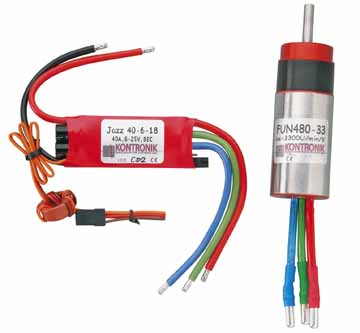
Photo from Hobbico Web Site Shows the Brushless Set 480
Brushless Set 480
- Includes: Fun 480-33 brushless motor; Jazz 40-6-18 ESC; KPG25 gear drive with 4.2:1 gear ratio
- For up to 10 cells
- High RPM for fast and slow sailplanes, and airplanes using 7-10 cells, including the HCA SuperStar* Select MkII; HCA SuperStar* 40; HCA Avistar* 40; GPM Ryan STA EP; GPM J-3 ElectriCub
Brushless Set 500
- Includes: Fun 500-27 brushless motor; Jazz 40-6-18 ESC; KPG27 gear drive with 5.2:1 gear ratio
- Good for mid-size electrics, including the KYO Spitfire 40; KYO Messerschmitt BF109E; KYO P-51D Mustang; KYO Pitts Special S-2C 40; KYO Piper J-3 Cub; KYO PT-17 Stearman 40; KYO Tiger Moth DH82; GPM Fokker DR1; GPM Piper J-3; GPM P-51D Mustang; GPM Tiger Moth
Brushless Set 600
- Includes: Fun 600-18 brushless motor; Jazz 60-10-32 ESC; KPG27 gear drive with 4.2:1 gear ratio
- For larger electric airplanes such as the GPM J-3 Piper Cub 81"
KONG2000 Fun 400-23 Brushless Motor
KONG2010 Fun 400-28 Brushless Motor
KONG2020 Fun 400-36 Brushless Motor
Retail $189.99
Street 149.99
KONG2035 Fun 480-28 Brushless Motor
KONG2040 Fun 480-33 Brushless Motor
Retail $199.99
Street 159.99
KONG2100 Fun 500-27 Brushless Motor
Retail $229.99
Street 179.99
KONG2200 Fun 600-17 Brushless Motor
Retail $249.99
Street 199.99
KONG5000 Brushless Set 400
Retail $319.99
Street 249.99
KONG5020 Brushless Set 480
Retail $449.99
Street 349.99
KONG5040 Brushless Set 500
Retail $499.99
Street 379.99
KONG5060 Brushless Set 600
Reta Retail $599.99
Street 479.99
KONM3000 Smile 30-6-12 Brushless ESC
Retail $139.99
Street 109.99
KONM3020 Smile 40-6-12 Brushless ESC
Retail $169.99
Street 129.99
KONM3100 Jazz 40-6-18 Brushless ESC
Retail $229.99
Street 179.99
IN STOCK NOW OR COMING SOON!
Return to "What's In This Issue?"
The January 2004 EFO Meeting
On a cold, January evening, the several EFO members gathered at Ken's house for the January meeting.

Richard Utkan brought along a "top" R/C plane that he'd picked up cheaply. He is shown getting help from Jack Lemon. It seems that the plane only has about 10 feet of radio range right out of the box.

Jack Lemon showed off his scratch-built, yet based on the Herr Bonanza. It weighed in at 10 oz. It is a delight, and the window treatment is excellent.
Dave Stacer shared a flying-wing built of blue foam. The plans are from the foamfly.com site. The motor is cheaper than the two magnets used on the hold-down/hatch. The Expo is an 80% version of this plane with forward swept wing. It is based on plans from the foamfly.com site. His 80% version is flying well. He thinks that it flies better than the larger one that he has with a S400 motor. He has the most fun when flying this version of the Expo. Both planes have several flights on them at the dome. Both planes are shown below.

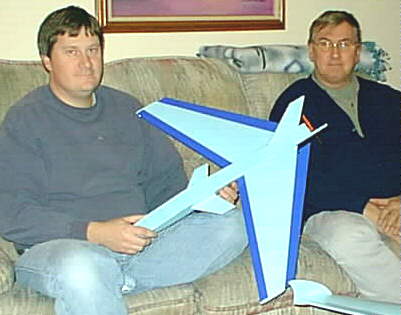
Ken shared the information on the EasyStar. The information appeared in last month's Ampeer.
 The following pictures were taken at the Oakland Yard dome during our holiday party meeting there. The following pictures were taken at the Oakland Yard dome during our holiday party meeting there.
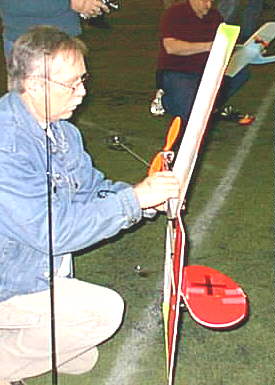
Richard prepares his Lite Stick for flight with someone's antenna in the way!
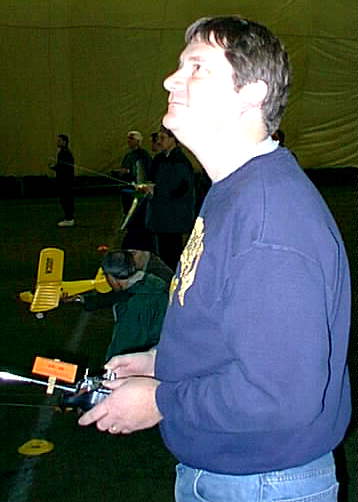
Dave Stacer concentrates on flying.
Return to "What's In This Issue?"
Multiplex EasyStar RTF Revisited
I received the following email, and thought I should fill in some of the blanks I
seemed to have left in the original review. KM
From Gordy Sthal GordySoar@aol.com
Hi Ken,
I went to the page and read your review of the Easy Star.
While it was very detailed do you realize that the review was not of the Easy Star but of the motor, battery, speed control and stuff/tests concerning them.
Not a criticism but at one point you state that you wanted to find out what kind of 'flyer' this plane was as your goal for the review. (remember the other guy said not a Park Flyer but an Athletic field..".
You show a photo of the Easy Flyer, and the title is Review of the Easy Flyer. There plenty of text about your waiting for it to come, what you had for dinner, the weather and the lack of proportionality of the speed control....you did at one point mention that it flew okay in the wind.
Kind of like teaching math class but spending most of the hour talking about pencils and ways to sharpen them for use on solving math problems :)
So was the kit worth the money? Was it applicable as a slow flyer, you know you could fly it in a cul de sac..Park Flyer, fly it at the local baseball diamond or school yard? What happened when it landed hard? Good loops, flew inverted, thermaled with the motor off, easy assembly, noisy, could add ailerons for more aerobatic fun?
Just wondering :)
Gordy
Okay Gordy, here's a bit more direct info about the airframe.
The reason there was so much "other stuff" in the original review was that it was for the RTF version, which included the airframe and the equipment supplied to get it flying.
This plane is factory set up for a total novice to fly. Using the factory control setup, it is not aerobatic, nor does the design lend itself to aerobatics. It should loop, but I've not tried that. It flies easily, with just a few R/C interrupts to keep it in the area where it is being flown. In winds up to about 10 mph, it should not be a problem as a trainer plane. Landings are exceptionally easy, given enough room to just let it settle in with a touch of up near the end, when the speed has decreased.
It is exceptionally easy to assemble and takes hardly any time at all.
Because it is a powered glider, it requires a bit of room to settle, since there are no spoilers. I feel that a total novice needs at least 300 yards by 100 yards of obstacle free space to fly and land safely. It is not a slow flier or even park flyer. The more room the better.
It should thermal just fine and quite easily, for those who have the ability. It flies just fine for a beginner to R/C using it as a powered R/C trainer.
Because it is direct drive, it is very quiet with the motor on.
So far, the hardest landing was a couple of foot "thud", landing on its belly, when I forced it down on its first flight. No damage at all.
While, with enough effort, ailerons can be added to almost anything, they would most likely not benefit this design, as the airfoil is slightly under cambered.
I feel the whole unit is a very good buy for the complete novice. The airframe design is excellent, and the provided equipment is useful. It is a decent value.
It is designed and marketed as an R/C trainer, and that it what it is. Some accomplished pilots would find it a relaxing traveling companion. It is just the sort of thing to relax with while chatting with other pilots or spectators at the end of the day. It is also something the accomplished pilot would use to introduce the novice to this hobby.
Return to "What's In This Issue?"
VK Camel
From: Walt Thyng docwt@lightfirst.com

Hi Ken,
I just got around to reading the January Ampeer. It is one of the best in quite a while. Thanks.
I'm tweaking the bones on my VK Camel, before disassembly, final sanding and covering.
Financial reality finally caught up with me and I'm going to power it with one of my Astro 25Gs on a Superbox instead of buying an outrunner brushless. I just thought it would be very cool to have a rotary motor in a rotary-engine plane! I even thought about attaching a very lightweight, carefully balanced rotary motor to the outrunner case so that it would actually turn like the original (albeit in the wrong direction).
I'm not a true scale builder, but I've added a few touches like a working spring loaded tail skid, simulated top wing aileron cables and full correct flying, landing and support wires; also scale rudder and elevator cables. I'm going to finish it in the "Dimps III" color scheme shown in "Sopwith Aircraft of WWI." It is all over white with an orange sunburst on the top wing and horizontal stab; red chord-wise stripes on the top of the lower wing with a red nose and forward fuselage.
I've never seen a Camel in that scheme before. Hope nobody else beats me to it like they did the Air Sea Rescue DC-3 (RF4?).
The photo is of my VK Camel "in flagrante delcto."
Thanks for your reply on the E-flight list regarding power for my C47. I'm now considering Kyosho Endoplasmas with MAS gearboxes. With two motors and gearboxes for about half the price of one Astro 035, at that price I could replace the motors once a year for ten years and still come out even (if the plane even lasts that long )-: ).
Walt Thyng
Return to "What's In This Issue?"
|



